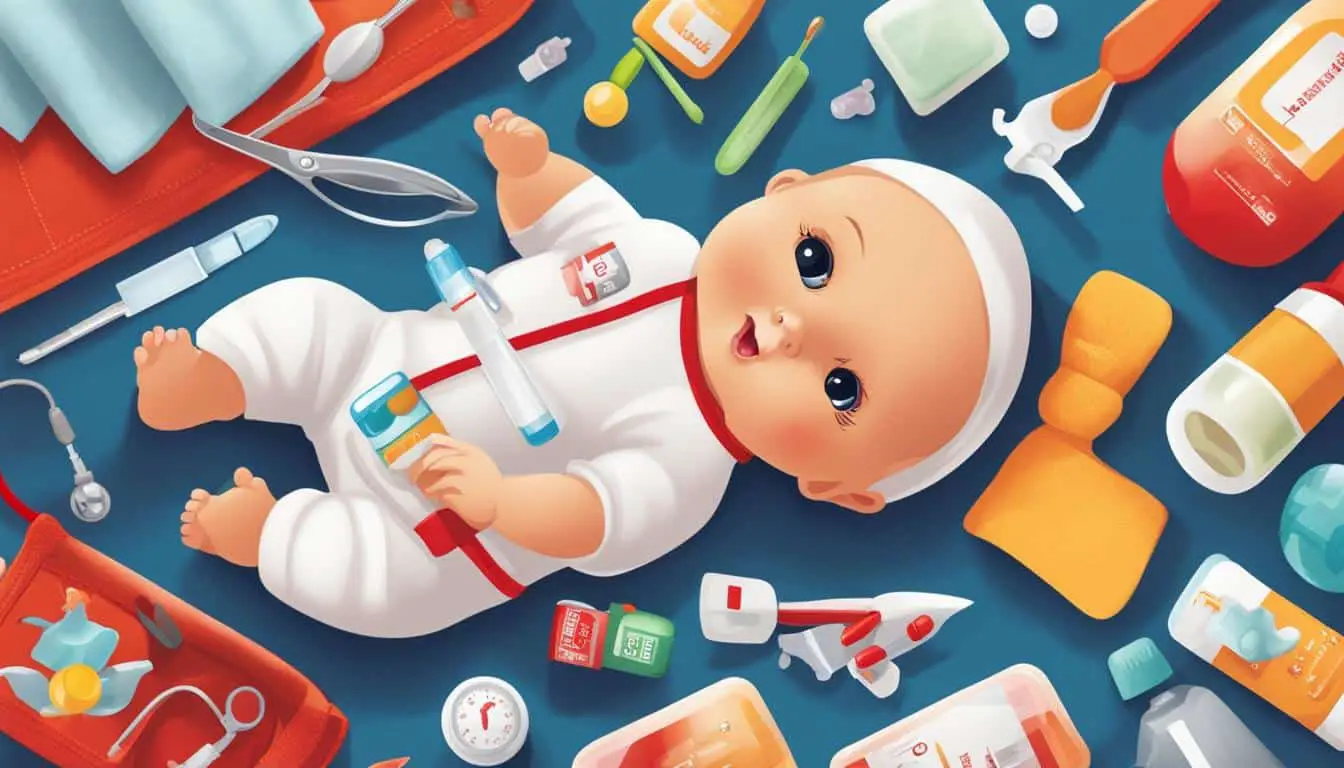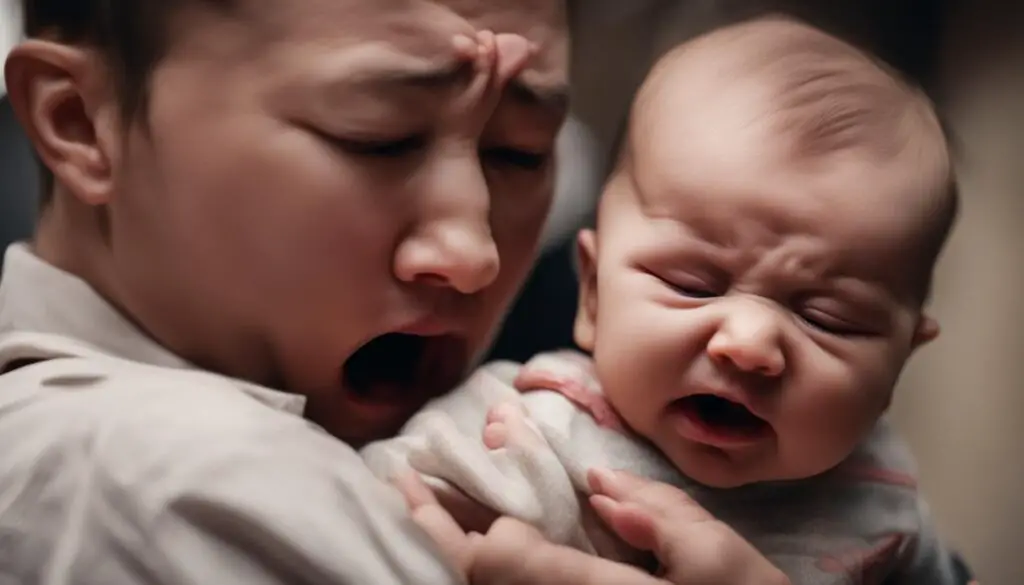
First Aid for Babies: Essential Knowledge for Every Parent
Knowing the essential first aid skills for your baby is crucial for their safety and well-being. In this section, I will outline five important first aid emergencies that may affect your baby and provide step-by-step instructions on what parents should do in each situation.
The information provided in this article is sourced from various reputable sources and covers topics such as choking, unconsciousness and not breathing, febrile convulsions and seizures, head injuries, and burns. By understanding and being prepared for these situations, parents can confidently respond to emergencies and potentially save their baby’s life.
Key Takeaways:
- Knowing essential first aid skills can make a big difference in your baby’s safety
- Be prepared for emergencies such as choking, unconsciousness, febrile convulsions, head injuries, and burns
- Learn step-by-step instructions on how to respond to these emergencies
- Consider taking a certified CPR and first aid training course for hands-on experience
- By being prepared, parents can confidently respond to emergencies and save their baby’s life
How to Respond to Choking Baby
Choking is a distressing emergency that can occur to babies, and knowing how to respond quickly and effectively is crucial for parents. If your baby is choking, follow these step-by-step instructions to help clear their airway and prevent further complications.
1. Check the baby’s mouth for obvious obstructions
Begin by carefully opening the baby’s mouth and looking for any visible objects that may be causing the blockage. If you can see and safely remove the obstruction, do so gently using your fingers. Be cautious not to push the object further down the throat.
2. Perform back blows and chest thrusts
If the obstruction cannot be removed by simply checking the mouth, it is time to perform back blows and chest thrusts. Position yourself behind the baby and provide support by placing your forearm on their chest and your hand on their head. Deliver firm but gentle blows to the back between the shoulder blades using the heel of your hand. Then, turn the baby over and perform chest thrusts by using two fingers to push down on the center of the chest, just below the nipple line.
3. Know when to call emergency services
If the obstruction remains after attempting back blows and chest thrusts, it is crucial to call emergency services immediately. Keep repeating the back blows and chest thrusts until help arrives.

Remember, learning infant CPR can provide valuable skills and knowledge in dealing with choking emergencies. Consider taking a certified CPR and first aid training course to gain confidence and ensure you are prepared to handle any emergency situation that may arise.
First Aid for Unconscious and Not Breathing Baby
When a baby becomes unconscious and stops breathing, immediate action is necessary to potentially save their life. Knowing how to perform infant CPR is essential for parents in these critical situations. Follow the step-by-step guide below to provide the necessary first aid for an unconscious and not breathing baby:
- Ensure safety: Assess the environment for any potential dangers.
- Check responsiveness: Gently tap the baby’s foot and speak loudly to check if they respond. If there is no response, shout for help.
- Open the airway: Place the baby on their back and carefully tilt their head back to open the airway. Use your finger to clear any visible obstructions.
- Administer chest compressions and rescue breaths: Place two fingers at the center of the baby’s chest, just below the nipple line. Perform 30 chest compressions at a rate of 100-120 compressions per minute. After the compressions, give two gentle rescue breaths by covering the baby’s mouth and nose with your mouth and blowing until the chest rises.
- Continue cycles of compressions and breaths: Repeat the cycles of 30 compressions and 2 rescue breaths until the baby starts breathing on their own, emergency help arrives, or you are too exhausted to continue.
If at any point you notice signs of life such as coughing, breathing, or movement, stop CPR and monitor the baby until help arrives. Remember, it’s crucial to start CPR immediately and continue until professional medical assistance arrives.
“Performing infant CPR can be intimidating, but it’s an essential skill that every parent should learn. By taking prompt action and administering CPR correctly, you can greatly increase the chances of a positive outcome for an unconscious and not breathing baby.” – Dr. Emily Johnson, Pediatrician
By familiarizing yourself with the steps involved in infant CPR, you can help ensure your preparedness to respond effectively in emergency situations. Remember, it’s always advisable to attend a certified CPR training course to gain practical experience and confidence in performing infant CPR. Proactive education and swift action can make a lifesaving difference for your baby.
| Signs of Life | Actions |
|---|---|
| Coughing, breathing, or movement | Stop CPR, monitor the baby, and wait for help to arrive |
First Aid for Other Common Baby Emergencies
When it comes to babies, accidents can happen unexpectedly. It is important for parents to be prepared for common emergencies that their little ones may encounter. In this section, I will discuss how to handle febrile convulsions, head injuries, burns, and bleeding.
Febrile Convulsions
Febrile convulsions, or seizures, can be a frightening experience for both parents and babies. They occur when a child’s body temperature rises rapidly, usually due to an infection. If your baby has a febrile convulsion, it is important to stay calm and take immediate action.
In the event of a febrile convulsion, lay your baby on their side to prevent choking and protect their airway. Remove any nearby objects that may cause harm. Do not try to restrain your baby or put anything in their mouth. Instead, focus on keeping them safe and monitor the duration of the seizure.
It is important to seek medical attention after a febrile convulsion to determine the underlying cause and prevent future episodes. Remember, febrile convulsions are usually harmless and do not cause long-term damage.
Head Injuries
Head injuries can occur from falls, bumps, or accidents. If your baby sustains a head injury, it is crucial to assess the severity and take appropriate action.
If your baby has a minor head injury, closely observe them for any changes in behavior, vomiting, or loss of consciousness. Apply a cold compress to the injured area to reduce swelling, and keep your baby calm and comfortable.
However, if your baby exhibits any signs of a severe head injury, such as unconsciousness, prolonged crying, or bleeding from the nose or ears, it is important to seek immediate medical attention. Do not move your baby unless they are in immediate danger, and call for emergency assistance.
Burns and Bleeding
Accidental burns and bleeding are common concerns for parents. In the event of a burn, immediately cool the affected area under cool running water for at least 10 minutes. Avoid using ice or placing any creams or ointments on the burn.
To control bleeding, apply gentle pressure with a clean cloth or bandage to the wound. Elevate the injured area if possible and seek medical attention if the bleeding does not stop after applying pressure for 10 minutes.
Remember, these are just general guidelines for handling common baby emergencies. It is always best to consult a healthcare professional or call emergency services if you have any doubts or concerns about your baby’s health and well-being.
| Emergency | Actions |
|---|---|
| Febrile Convulsions | – Lay baby on their side – Remove nearby objects – Do not restrain or put anything in the mouth – Seek medical attention after the seizure |
| Head Injuries | – Assess severity – Observe for changes in behavior – Apply cold compress – Seek immediate medical attention for severe head injuries |
| Burns | – Cool under cool running water for 10 minutes – Do not use ice or creams – Seek medical attention for severe burns |
| Bleeding | – Apply gentle pressure with a clean cloth or bandage – Elevate the injured area if possible – Seek medical attention if bleeding does not stop after 10 minutes |
Conclusion
In conclusion, having the necessary knowledge and skills in baby first aid essentials is crucial for every parent. This article has provided comprehensive information on how to respond to choking, perform infant CPR, and handle other common emergencies that may arise with babies. By following the step-by-step instructions outlined in this article, parents can be prepared to take immediate action in critical situations and potentially save their baby’s life.
It is important to remember that learning from reliable sources and practicing these techniques is essential. To further enhance their preparedness, parents are recommended to consider taking a certified CPR and first aid training course. These courses provide hands-on experience and build confidence in providing first aid care for babies, allowing parents to respond to emergencies with more efficiency and effectiveness.
By equipping themselves with the knowledge and skills from this article and attending a certified training course, parents can ensure the safety and well-being of their babies in emergency situations. Being prepared and acting quickly and appropriately can make a significant difference in the outcome of an emergency. Remember, the safety of your baby is in your hands, and being prepared is the first step in providing effective emergency response for babies.
So, take the time to familiarize yourself with the information provided in this article and consider seeking out a certified CPR and first aid training course. By doing so, you will be empowered to confidently handle emergencies and protect the most precious gift in your life – your baby.
FAQ
What are the essential first aid skills for babies?
The essential first aid skills for babies include knowing how to respond to choking, performing infant CPR, and handling other common emergencies such as febrile convulsions, head injuries, burns, and bleeding.
How should I respond if my baby is choking?
If your baby is choking, you should check their mouth for obstructions, perform back blows and chest thrusts, and call emergency services if necessary. It is important to follow the recommended techniques for clearing a baby’s airway in cases of choking.
What should I do if my baby is unconscious and not breathing?
If your baby is unconscious and not breathing, you should perform infant CPR immediately. This involves checking for danger, responsiveness, opening the airway, and administering chest compressions and rescue breaths. It is crucial to start CPR while waiting for emergency services to arrive.
How can I handle febrile convulsions, head injuries, burns, and bleeding in my baby?
To handle febrile convulsions, it is important to maintain safety, manage a fever, and seek medical attention if necessary. For head injuries, it is crucial to monitor your baby for symptoms and seek medical help if needed. To treat burns, you should cool the burn under running water and seek medical advice. To control bleeding, you can apply pressure to the affected area with a clean cloth or bandage.
How can I be prepared to respond to emergencies involving my baby?
Being equipped with first aid knowledge and skills is essential for parents. By following the guidelines outlined in this article and considering taking a certified CPR and first aid training course, parents can be prepared to act quickly and effectively in critical situations concerning their babies.